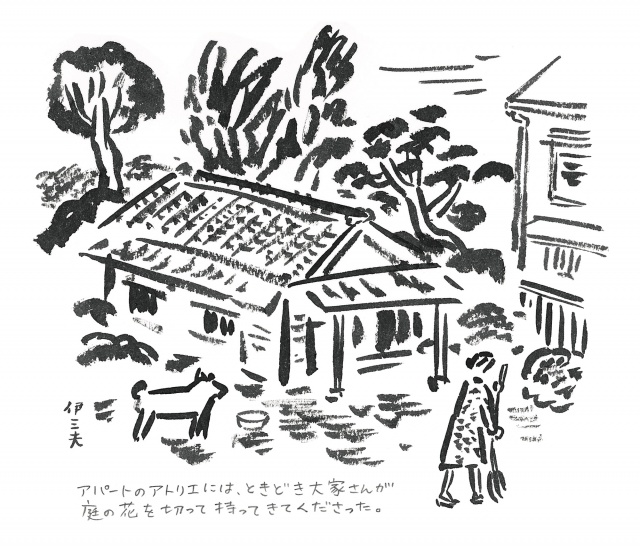vol.
016
MARCH
2017
vol.016 / Tokyo Transitions
Atelier
Text and Illustration by Isao Makino

My life in Tokyo began in 1983, when I entered an art university in Hachioji. The university was deep in the mountains, far from Hachioji Station, so I lived alone in a student dorm right next to the school buildings. From there I could see the herd of sheep in the field of grass on the next mountain over; it was completely different from the image of Tokyo I’d painted in my mind’s eye when I left home.
So, when I was going to school, I drew pictures in the classroom, but after that I had to raise the money for my atelier by myself. After I graduated I entered the workforce, but there wasn’t enough money to rent an atelier in addition to my house. At the time I lived in a stylish one-room apartment in Fuchu, and I put my desk and bed on the balcony when I painted large pictures. I knew the landlord would get angry at me if I dirtied the walls and floor with my supplies, so I had to spread a giant vinyl sheet through the apartment, but I couldn’t really relax in that environment, so I moved to a two-room apartment in Musashi Koganei and made the spare room my studio. It was a wooden building with thin walls, and I, being young, struggled with being able to hear the next-door couple making love through the walls, but a landlord on the premises had a garden with bamboo, pines, and oak trees growing all around. It really felt like Musashino. Looking out over that scene from my window was heart-warming, and I came to believe that this being in an old, relaxed environment was important for painting. I quit my job and holed up in my atelier, where I began my life as a painter. However, a few years later, I had to leave because of issues with the landlord. So I’ve moved to a house in the neighborhood, with plum and apricot trees in its large garden. There, I remodeled a row house built next to the garden, and laid wooden floors so that you can enter with your shoes on, like they do in the West, and turned it into my atelier. However, after a while I had to move again on request of the landlord, and ever since then I’ve been moving around, searching for the perfect house in which to paint.
I can relax and paint in old row houses, and right now I live in a house that’s 47 years old, but recently there have been discussions about me moving out. Developments around the station have pushed up the price of the land, and they’re saying they want to sell it off somewhere. It’s like hermit crab painters are being expelled one after another by Tokyo’s city developments.
Translation: Office Miyazaki, Inc.



